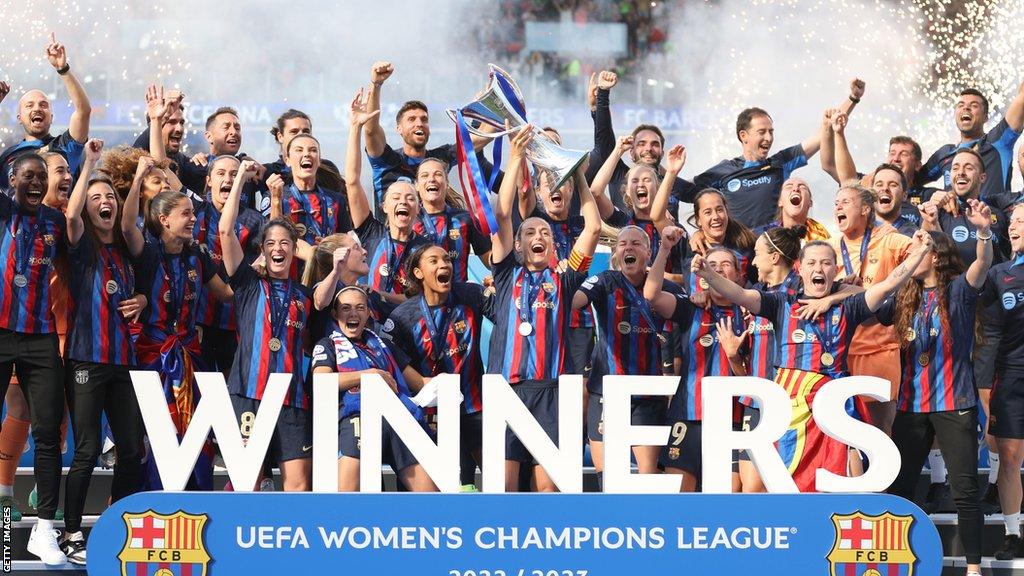Deloitte Money League: 'Explosion of interest' in women's football as revenues rise
- Published

Barcelona won the Women's Champions League, Liga F and Women's Spanish Super Cup last season
Average revenues of the top 15 women's football clubs in Europe grew by 61% to 4.3m euros (£3.7m) over the last year, according to analysis by Deloitte.
All but three of the 15 clubs in their Money League study recorded double-digit revenue growth in 2022-23.
Barcelona stay top after revenues increased by 74% to 13.4m euros (£11.5m), with Manchester United second with 8m euros (£6.8m).
Real Madrid are third with €7.4m (£6.3m) - a 416% rise from 2021-22.
Manchester City and Arsenal complete the top five, with Chelsea sixth and Tottenham 10th.
There are eight Women's Super League (WSL) clubs in total, with Liverpool, Everton and West Ham 11th, 13th and 14th respectively.
"There's huge potential in women's football, we have seen this growth for a few years now so it proves it is not just a one off," Amy Clarke, women's sport lead in Deloitte's Sports Business Group, told BBC Sport.
"We are seeing huge explosion in interest in the women's game. We had record crowd and increased attendances last season resulting in higher matchday revenue. And we are seeing a really big focus on clubs becoming sustainable in their own right."
Figures for the men's game showed that commercial revenue overtook broadcast for the first time since 2016, prompting clubs to explore different revenue streams, something already well established in the women's game.
Unlike the men's game, which has traditionally relied on lucrative broadcast contracts, only 20% of the women's clubs average revenue came from broadcast deals last season, with commercial revenue accounting for 58% and matchday 22%.
Broadcast revenue across each league also varies greatly, with England's WSL and Spain's Liga F broadcast rights worth around 8m euros in 2022/23, approximately eight times that of Italy's Serie A Femminile (1m euros), which became fully professional from the 2022/23 season.
That means clubs have tried different ways of generating revenue, even within the same leagues. For example in the WSL, Manchester United generated 74% of its revenue through commercial partnerships, while Arsenal earned 58% of its revenue from matchday income after a number of sellout matches at the Emirates Stadium.
Clarke says that has led to a "test and learn, start-up culture" in women's football, with "room for experimentation both on and off the pitch".
"We have always said the women's game should not just copy the template of the men's game and this proves that point perfectly, with the men's game having to diversify for financial sustainability now they cannot rely on central broadcast contracts," said Clarke.
"The women's game has always had to think about their business model differently. That could be rethinking the matchday experience for the women's football fan, who may be more tech savvy for example, or in terms of the support the players and backroom staff have.
"In this digital age, that fanbase is going to stay with it now and will demand more from women's football. So I expect it to continue moving and adapting because that is the way it has always had to grow from the ground up."
Position | Club | 2022-23 revenue |
|---|---|---|
1 | Barcelona | £11.5m |
2 | Manchester United | £7m |
3 | Real Madrid | £6.5m |
4 | Manchester City | £4.6m |
5 | Arsenal | £4.6m |
6 | Chelsea | £3.5m |
7 | Paris St-Germain | £3.2m |
8 | Eintracht Frankfurt | £3.1m |
9 | Bayern Munich | £2.7m |
10 | Tottenham | £2.3m |
11 | Liverpool | £1.8m |
12 | Benfica | £1.3m |
13 | Everton | £1.1m |
14 | West Ham | £1.1m |
15 | Juventus | £1m |
For non-British clubs Deloitte has used an average exchange rate for the year ending 30 June 2023 (1 euro = GBP 0.87; 1 euro = BRL 5.4; 1 euro = USD 1.05).